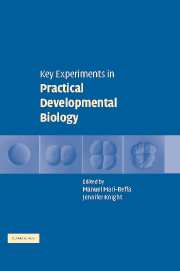Book contents
- Frontmatter
- Contents
- List of contributors
- Preface
- Introduction
- SECTION I GRAFTINGS
- SECTION II SPECIFIC CHEMICAL REAGENTS
- SECTION III BEAD IMPLANTATION
- SECTION IV NUCLEIC ACID INJECTIONS
- SECTION V GENETIC ANALYSIS
- SECTION VI CLONAL ANALYSIS
- SECTION VII IN SITU HYBRIDIZATION
- SECTION VIII TRANSGENIC ORGANISMS
- 19 Bicoid and Dorsal: Two transcriptions factor gradients which specify cell fates in the early Drosophila embryo
- 20 Significance of the temporal modulation of Hox gene expression on segment morphology
- 21 The UAS/GAL4 system for tissue-specific analysis of EGFR gene function in Drosophila melanogaster
- 22 Neurogenesis in Drosophila: A genetic approach
- 23 Role of the achaete-scute complex genes in the development of the adult peripheral nervous system of Drosophila melanogaster
- SECTION IX VERTEBRATE CLONING
- SECTION X CELL CULTURE
- SECTION XI EVO–DEVO STUDIES
- SECTION XII COMPUTATIONAL MODELLING
- Appendix 1 Abbreviations
- Appendix 2 Suppliers
- Index
- Plate Section
- References
20 - Significance of the temporal modulation of Hox gene expression on segment morphology
Published online by Cambridge University Press: 11 August 2009
- Frontmatter
- Contents
- List of contributors
- Preface
- Introduction
- SECTION I GRAFTINGS
- SECTION II SPECIFIC CHEMICAL REAGENTS
- SECTION III BEAD IMPLANTATION
- SECTION IV NUCLEIC ACID INJECTIONS
- SECTION V GENETIC ANALYSIS
- SECTION VI CLONAL ANALYSIS
- SECTION VII IN SITU HYBRIDIZATION
- SECTION VIII TRANSGENIC ORGANISMS
- 19 Bicoid and Dorsal: Two transcriptions factor gradients which specify cell fates in the early Drosophila embryo
- 20 Significance of the temporal modulation of Hox gene expression on segment morphology
- 21 The UAS/GAL4 system for tissue-specific analysis of EGFR gene function in Drosophila melanogaster
- 22 Neurogenesis in Drosophila: A genetic approach
- 23 Role of the achaete-scute complex genes in the development of the adult peripheral nervous system of Drosophila melanogaster
- SECTION IX VERTEBRATE CLONING
- SECTION X CELL CULTURE
- SECTION XI EVO–DEVO STUDIES
- SECTION XII COMPUTATIONAL MODELLING
- Appendix 1 Abbreviations
- Appendix 2 Suppliers
- Index
- Plate Section
- References
Summary
OBJECTIVE OF THE EXPERIMENT Hox genes control the morphology of segments in animals. During development Hox genes are expressed in defined regions, with a specific temporal–spatial dynamic expression in each segment. The purpose of these experiments is to observe the evolution of the temporal expression of some Hox genes and to manipulate their temporal expression to analyse how this affects segment morphology in Drosophila.
DEGREE OF DIFFICULTY Antibody staining is time consuming. RNA in situ hybridisation involves many washing steps, and the probe is susceptible to degradation.
The study of dynamic patterns of expression in embryo populations of mixed ages can be daunting to the nonexpert. In addition, the gastrulation movements and the variable orientations of the embryos in the slide make the identification of different stages of embryogenesis difficult.
INTRODUCTION
In the first two hours of embryogenesis the trunk of Drosophila is subdivided into identical segments that become morphologically different by the action of the Hox genes. Hox genes encode transcription factors that activate or repress downstream genes that are responsible of controlling the morphogenesis of the structures formed in each segment.
The trunk consists of three thoracic (T1–T3) and eight major abdominal segments (A1–A8). Some distinguishing features of the segments are the development of legs in the thorax, the formation of ventral denticle belts of different widths in the epidermis, and the formation of the posterior spiracles in A8 (Figure 20.1). In Drosophila, the legs are well developed only in the adult.
- Type
- Chapter
- Information
- Key Experiments in Practical Developmental Biology , pp. 255 - 268Publisher: Cambridge University PressPrint publication year: 2005



